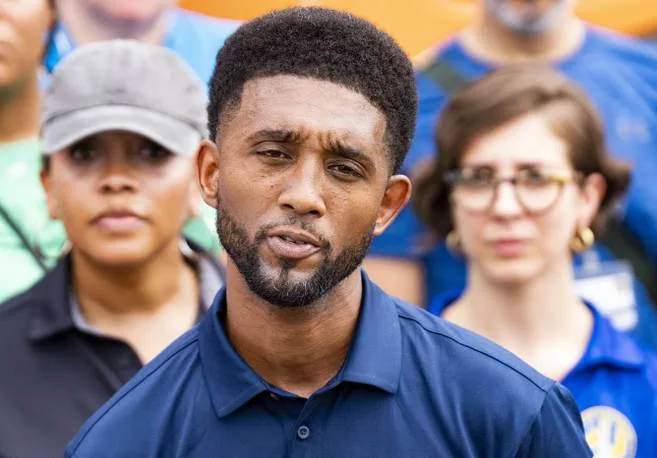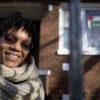
In the aftermath of an early morning shooting that injured more than two dozen people and left two young people dead, Mayor Brandon Scott’s administration has flooded the southernmost tip of the city.
Scott and his team have made trips to Brooklyn nearly every day since Sunday, fielding questions from residents at meetings, canvassing block-by-block and setting up a resource hub in the community center.
The Scott administration’s response is a challenge and an opportunity less than a year from when Baltimore voters will decide whether to grant him a second term. The scale of the shooting shocked the city and the nation, and Scott must now help the neighborhood heal, ensure the shooters are tracked down and prosecuted, and determine how and if city agencies could have averted the shooting.
Public safety is likely to be the top issue in next year’s mayor’s race, according to political experts, and voters will remember what could be the largest shooting in city history — and Scott’s leadership in the aftermath.
“It’s an opportunity for a leader to not just show improvement on the issue, which people want really badly, but also an opportunity to show how they respond, and how they coordinate resources, and how they try to make a difference,” said Roger Hartley, dean of the College of Public Affairs at the University of Baltimore. “A mayor who can do that, in the face of difficulty, can be rewarded with support.”
The task is daunting. Police have found casings from more than a dozen different guns at the scene, increasing the challenge of solving the crime. Brooklyn residents say their neighborhood has deteriorated and trust has broken down following years of city neglect.
And Scott will have to manage the response with many of the government’s highest profile roles — including the police commissioner, the health commissioner, the head of the city’s Office of Neighborhood Safety and Engagement, and the fire chief — all without permanent leaders.
Violent crime will be a top issue
So far, the mayor has pointed toward culprits outside his control to explain the chaos: Guns, the “cowardly” gunmen and inaction on gun regulation by the U.S. Congress among them. On Friday, Baltimore Police made an arrest, charging a 17-year-old with gun possession violations.
“This was an absolute tragedy that did not have to happen,” Scott told reporters at a Sunday morning news conference, hours after the shooting spree. “It again highlights the impacts and the need to deal with the over-proliferation of illegal guns on our streets, and the ability of those who should not have them to get their hands on them.”
The mayor also faulted adults at the party for not taking steps to alert the police to danger: “There were grown adults filming young people with guns, who said nothing, who did nothing,” he said. “We have to have a sense of responsibility to our own communities ourselves.”
Homicides may be dropping across the city overall, but the Scott administration is tasked with communicating that feat as high-profile killings, many of them involving young people, continue to leave scars.
Sign Up for Alerts
Get notified of need-to-know
info from The Banner
“This [violent crime] is a big issue, and it is the issue,” said Mileah Kromer, associate professor and director of the Sarah T. Hughes Center for Politics at Goucher College. “He [Scott] inherited a government that people already had a lot of distrust in. They want to see progress on this issue.”
And, Kromer added, voters need to see the mayor responding to other priorities, too. “Once you become the mayor and earn that elected position, all this stuff becomes your responsibility,” she said.
A 2022 Goucher College poll in partnership with The Baltimore Banner found that crime was the top issue for Baltimore residents surveyed — and as concerns about the pandemic and the economy recede, Kromer expects it to matter even more this upcoming cycle.
Scott administration questioned
Questions and criticisms about the Scott administration’s approach to crime will mount as it hits the campaign trail over the coming months — and so will probes about the effectiveness of city government under his watch.
The mayor has been less forthcoming this past week with answers about the role of police, city agencies and programs that he has championed, such as Safe Streets, in the lead-up to Sunday morning’s tragedy.
Former and current city officials have faulted an absence of communication among city agencies that should have prevented Brooklyn Day, an annual neighborhood block party, from spiraling into violence. And deep holes in Scott-backed city policies meant to keep young people out of harm’s way were exposed.
- Police say they did not know of the event until “several hours” before the shooting, even though it happened on the grounds of Brooklyn Homes, a public housing complex that is funded with public dollars. Radio traffic showed officers were aware of the crowd size and received a noise complaint, and a social media video circulated at least two hours before the shooting showing someone brandishing a weapon.
- The Housing Authority of Baltimore City, which owns and operates the public housing complex where the shooting occurred, would not say when they learned of the event, but faulted residents for not notifying them “properly.” The authority acknowledged the existence of security cameras on the grounds but wouldn’t say if they were being monitored that night.
- City-employed violence interventionists broke up three or four conflicts that night, but their shifts ended before the violence. And those workers are trained not to notify law enforcement about conflicts to maintain credibility in communities that might distrust the police.
- A newly rejuvenated curfew intended to thwart youth violence couldn’t be used at the block party, Scott said, because adults were present and some of the youths may have lived in the housing complex. Research has found that curfews are ineffective at reducing crime. And Baltimore has not vigorously enforced its curfew.
- And City Councilwoman Phylicia Porter — who faulted a “systemic failure” for the early morning eruption — hasn’t responded to questions about her own knowledge about the event or what, if any, steps she took to loop in the rest of the city.
City Councilman Mark Conway, chair of the city’s Public Safety and Government Operations Committee, will hold a hearing next week probing the role police and three other city agencies played, or didn’t play, in the lead-up to the escalation.
Much of the scrutiny has focused on police, who have acknowledged keeping away from the scene despite receiving calls about the crowd. The head of the police union said the force didn’t have enough staff, and Interim Commissioner Richard Worley said they didn’t know about the Brooklyn Day event early enough to form a plan.
Communication breakdown
Former Baltimore Mayor Sheila Dixon, who is considering another run next year after finishing behind Scott in the 2020 primary, said city agencies should have known about the block party.
“There was clearly a breakdown in communication,” said Dixon. “So many departments, as it relates to neighborhood outreach, have been beefed up — they should have had multiple agencies knowing stuff was going on.”
Dixon acknowledged that no tragedy of a similar scale occurred during her tenure as mayor — which ended in 2010 when she resigned her office as part of a plea deal in a corruption investigation. The city’s current administration has responded appropriately in the days since, she said, by deploying trauma teams and social workers to help survivors and their families pick up the pieces while also committing to finding the killers.
But Dixon zeroed in on the Mayor’s Office of Neighborhood Safety and Engagement — known as MONSE — a new entity established under Scott in 2020 that aims to take a holistic approach to violence. The office, considered a signature initiative of the Scott administration, has grown swiftly during the last three years to include more than 30 staffers and a $22 million budget. Their responsibilities include coordinating violence intervention work and overseeing programs, including Safe Streets.
A Johns Hopkins University analysis of the efficacy of Safe Streets published this past March found that while the organization has been associated with lower amounts of gun violence overall, the Brooklyn neighborhood has seen a 27% increase over the past four years.
Scott said his office is examining what steps city agencies and partners take before and after incidents of violence to ensure “something like this” doesn’t happen again. He also doubled down on MONSE’s and Safe Streets’ approach to conflict.
“This cowardly, violent act of a few on Sunday does not negate the brave work of violence interrupters and community activists who are helping to heal our communities,” Scott said in the statement.
MONSE spokesman Jack French said the agency is assessing its internal protocols.
Watching Scott’s leadership
As he responds to critiques of the administration and agencies, Scott also will be challenged on city government’s record in Brooklyn and other South Baltimore communities whose problems are often overshadowed by other parts of the city.
Cut off from the rest of Baltimore by I-95, the Brooklyn neighborhood has suffered from generations of neglect, political indifference and economic disinvestment, said Karsonya “Kaye” Wise Whitehead, professor of communications and African American studies at Loyola University Maryland and host of “Today with Dr. Kaye” on WEAA-FM.
“This has been brewing for a long time,” she said.
The mayor’s office has promised to fill the community with help and resources for 45 days.
”What happens on Day 46? How do we restitch these communities back into the Greater Baltimore City?” Whitehead asked. “You cannot turn around decades of neglect in 45 days.”
What Scott and his team deliver in Brooklyn — and how transparent he is about the breakdowns that happened within his purview — could go a long way as voters mull their options next year, University of Baltimore’s Hartley said.
“There is now an opportunity to listen, which is something that’s so important: to listen and learn about what isn’t happening in a neighborhood,” Hartley said. “If there was a lot of listening, what does that lead to? OK, what now?”


